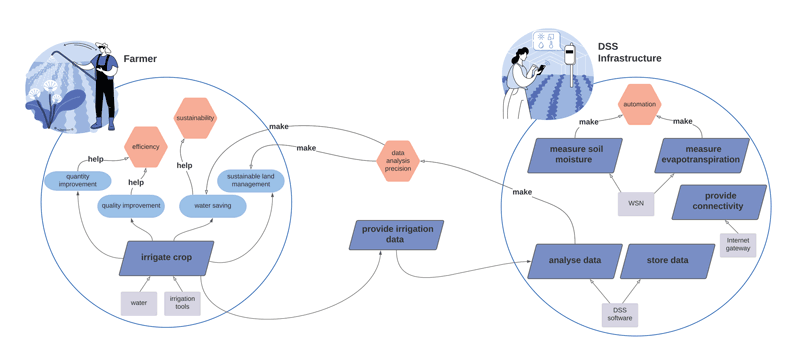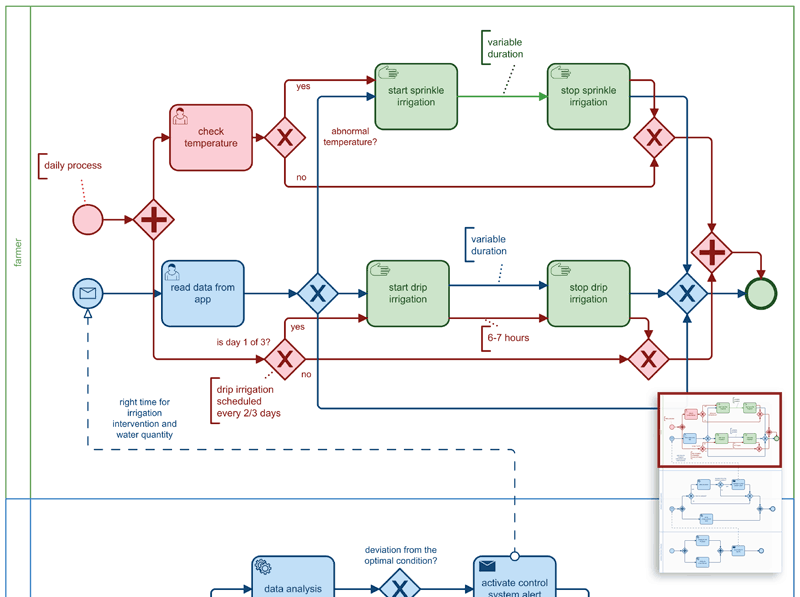by Chiara Mannari, Alessio Ferrari, and Manlio Bacco (CNR-ISTI)
The adoption of digital technologies in rural areas holds promising potential in terms of economic, productive and environmental benefits, in line with the United Nations (UN) Sustainable Development Goals (SDGs). However, digitalisation is a socio-technical process presenting challenges at multiple levels. Socio-technical process modelling supports interdisciplinary teams in the early evaluation of the impacts of digitalisation in real contexts by performing representations of business processes transformed after the introduction of digital solutions.
The adoption of digital technologies in rural areas has raised significant attention in recent years. Historically, technological innovations in agriculture and rural areas in general have led to substantial economic, social and environmental transformations. Nowadays, Internet of Things (IoT) components allow the development of sophisticated applications, Artificial Intelligence (AI) can contribute to automating manual tasks, and 5G networking, handheld devices and edge computing can make the technology more user-friendly, accessible and affordable to users, in line with the UN SDGs.
However, the transition towards smart rural areas is a socio-technical process of digitalisation presenting challenges with double-edged effects and generating potential winners and losers. To minimise the risk of undesired consequences, it is becoming increasingly important to support early evaluation of the impacts of digitalisation by performing analysis from multiple perspectives, including social and economic [1].
In such a context, Socio-technical Process Modelling (STPM) can support multiple stakeholders and interdisciplinary research teams in the analysis of digitalisation by providing easy-to-read graphical representations of the transformation of business processes after the introduction of digital technologies.
The STPM method is being developed by a research team at the Institute of Information Science and Technologies “A. Faedo” (ISTI) of CNR in the context of the Horizon Europe project “CODECS: Maximizing the co-benefits of agricultural digitalisation through conducive digital ecosystems” (2022-2026) coordinated by the University of Pisa [L1].
The method is based on the application of Model-driven Requirements Engineering techniques (MoDRE) leveraging different diagrammatic notations to model the process-as-is and the process-to-be in the context of the transformation of business agricultural processes after the introduction of digital technology.
To ensure completeness, the representation of a process transformation focuses on complementary dimensions corresponding to three types of models, i.e. structure, goal and process. These models are developed using different formal notations:
- Structure: the UML class diagram provides an overview of the process structure extending to the system in which the process is being applied. This model includes actors, resources, tools, and infrastructure involved in the process-to-be and their relationships (Figure 1).
- Goal: the iStar diagram models the actors, goals and activities of the process-to-be focusing on the intentional, social and strategic dimensions (Figure 2).
- Process: the BPMN diagram represents the detailed flow of the process, including actors’ tasks, procedures and communications. For this type of model, multiple diagrams are developed to represent both the process-as-is and the process-to-be. Furthermore, an overlapping visualisation allows comparisons between the process-as-is and the process-to-be (Figure 3).

Figure 1: UML class diagram representing the process structure.

Figure 2: iStar goal diagram representing the actors’ goals towards the process.

The formal representations resulting from the STPM method constitute an insight into understanding the process transformation and design material for further development.
As part of the project activities, the method is being applied to 20 European Living Labs that are part of the CODECS Consortium. Living Labs are communities of local practices, including farmers, knowledge intermediaries, stakeholders, and policymakers carrying out co-design activities to address emerging challenges. In these collaborative environments, the discussion of environmental sustainability coupled with the challenge of digital transformation has promising potential in the design and evaluation of services that meet users’ and societal needs. An inventory of the most widespread technologies for agriculture can be extracted from the use cases from the CODECS Living Labs. A consistent part of the digital solutions under evaluation is related to precision agriculture systems. These can include IoT components and machine learning models at different levels of technological maturity and integration in context. Figures 1, 2 and 3 illustrate a case study of an irrigation process transformed after the introduction of a precision irrigation system. To support the analysis of the process re-engineering impacts, the STPM method is applied in different situations and for multiple purposes through a collaborative procedure for data collection and graphical modelling.
In the context of CODECS, the modelling activity is performed pursuing the following objectives: support information exchange between stakeholders; understand how current processes are re-engineered; drive further analysis, e.g. cost-benefits analysis; elicit requirements for human-centric digital solutions.
The overall objective of the method is to include domain experts and practitioners both in the evaluation of available solutions and in the design and development of new digital technologies for agriculture following a human-centric approach.
This work has received funding from the European Union’s Horizon Europe research and innovation programme under grant agreement no. 101060179.
Link:
[L1] https://www.horizoncodecs.eu
References:
[1] A. Ferrari, et al., “Drivers, barriers and impacts of digitalisation in rural areas from the viewpoint of experts,” Information and Software Technology, vol. 145, 2022.
[2] W. van der Aalst, Process mining: Discovery, Conformance and Enhancement of Business Processes, vol. 2. Springer (2011).
[3] E. Yu, et al., Social Modeling for Requirements Engineering, The MIT Press, 2010.
Please contact:
Chiara Mannari, Institute of Information Science and Technologies “Alessandro Faedo” (ISTI), CNR, Pisa, Italy
+39 349 7386388











